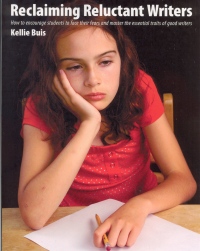| ________________
CM . . .
. Volume XIV Number 18. . . .May 2, 2008
excerpt:
We have all taught students who hate writing. They may refuse to write or write so little that it is impossible to assess their work. For these students, writing has become mundane, dull, and a waste of time. These students are reluctant writers. As teachers, we ask ourselves, how do we reignite their enthusiasm for writing? In Reclaiming Reluctant Writers, Kellie Buis takes on the task of helping teachers reshape their writing programs to engage students who have become disillusioned and disheartened with writing. Chapter one of Reclaiming Reluctant Writers outlines how teachers should use a combination of process writing and the explicit teaching of genre to create an enabling environment for reluctant writers. Chapters two through seven each introduce critical success factors that teachers need to address in order to change their teaching of writing. The six success factors Buis examines in the book revolve around nurturing a series of skills and abilities: the discovery and flow of ideas, fluency, style, organization, reflective revising, editing, and publishing, and finally, nurturing pride. Throughout the book, Buis explores key ideas about writing by debunking myths and examining the reality of reluctant writers. She then discusses the challenge that the reality of reluctant writers presents for classroom teachers.
In order for teachers to change teaching practices, Buis outlines a number of fundamental teaching and learning strategies to engage reluctant writers. Buis calls this process of teaching and learning an "action plan" and recommends that a teacher use an action plan format to teach six to twelve different genres per year. These action plans are made up of a series of activities. First, she explains that students need to learn and become inspired through hands-on events, just as they were in the primary grades; Buis calls these experiential learning activities "eyewitness events." As teachers, we often tell students to write about what they know, and these eyewitness events allow students to write about first-hand experiences. For example, if students are writing poetry about nature, the students could go on a nature walk. Buis also advocates for the use of a number of writers' tools and tasks, including eyewitness notebooks (in which, for example, students would write freely about their feelings and sights on the nature walk), free writes, and progress journals. Two key teaching strategies that Buis presents in action plans are read-alouds (teachers read texts aloud to the class) and write-alouds (teachers model how to write a text and explain their thinking process as they write). To help students organize their writing, Buis includes eyewitness organizers to help students plan their work. Finally, peer conferencing and student-led exhibitions give a purpose for reluctant writers to share their work and have pride in it.
Recommended. Kristen Ferguson teaches Language Arts at the Faculty of Education at Nipissing University and is a doctoral student in Education at York University.
To comment
on this title or this review, send mail to cm@umanitoba.ca.
Copyright © the Manitoba Library Association. Reproduction for personal
use is permitted only if this copyright notice is maintained. Any
other reproduction is prohibited without permission.
NEXT REVIEW |
TABLE OF CONTENTS FOR THIS ISSUE
- May 2, 2008.
AUTHORS |
TITLES |
MEDIA REVIEWS |
PROFILES |
BACK ISSUES |
SEARCH |
CMARCHIVE |
HOME |
